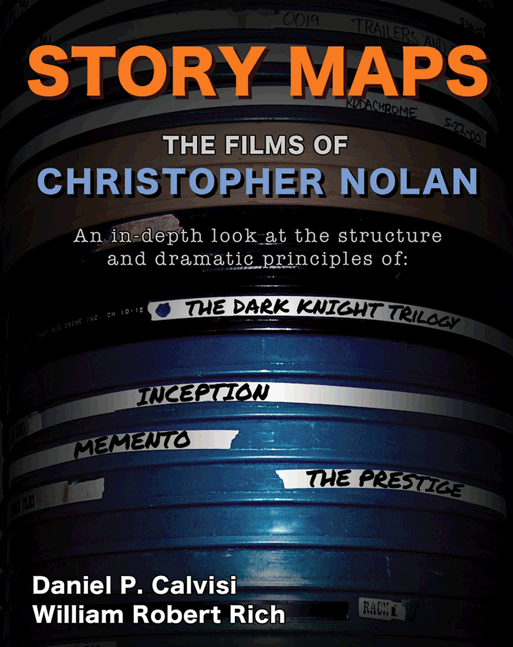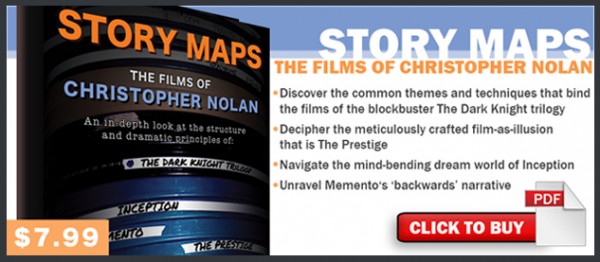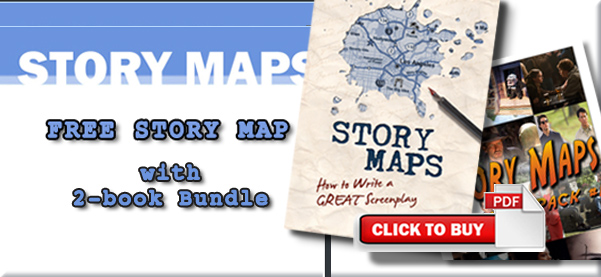-
Discover the common themes and techniques that bind the films of the blockbuster The Dark Knight trilogy
-
Navigate the mind-bending dream world of Inception
-
Decipher the meticulously crafted “film-as-illusion” that is The Prestige
-
Unravel Memento‘s ‘backwards’ narrative
“Story Maps: The Films of Christopher Nolan functions quite eloquently as an intricately detailed and compelling look into one of today’s most successful working directors. Each [story map] works to bolster Calvisi and Rich’s original analysis of Nolan’s filmography and functions as much as an analysis of Nolan the filmmaker as it does an analysis of story structure within his films.“ -Brad Johnson, Script Magazine
Story Maps: The Films of Christopher Nolan is the most detailed analysis of this brilliant director’s storytelling techniques ever written, and is sold exclusively here in PDF format. PDF allows you to print the e-book, use the super-fast bookmark navigation and it also includes the blank Story Map Worksheet for your own use.
Unlock the storytelling secrets of some of the most popular and complex movies of all time: MEMENTO, BATMAN BEGINS, THE PRESTIGE, THE DARK KNIGHT, INCEPTION and THE DARK KNIGHT RISES.
“…ideas like utilizing a fractured narrative, parallel lines of action, thematic explorations of time and memory, and an obsessive and/or haunted hero – they lay the groundwork for their analysis of each individual film later on.” -Brad Johnson, Script Magazine
Christopher Nolan and his frequent writing partners David Goyer and Jonathan Nolan are known for complicated narratives that seem to break all of the rules of screenwriting structure and demand multiple viewings and intense analysis to understand. But when you see their movies broken down into the practical and accessible template known as the Story Map, the classic techniques and advanced writing methods of these densely-plotted masterpieces reveal themselves.
Purchase for Amazon Kindle
I co-authored this book with Screenplay How To‘s William Robert Rich out of our mutual passion for Christopher Nolan’s movies and screenplays. We are fans first, having marveled at Nolan’s ability to weave a story while entertaining on an epic scale. As screenwriters and story analysts, we saw this book as a mighty challenge — honestly, these movies are the Mount Everest of Story Mapping!
“…Add in the fact that Calvisi and Rich include a story map worksheet to use on your own screenplay, or to analyze other scripts on your own, and you’ll more than get your money’s worth with this new addition to the Story Maps series.” -Brad Johnson, Script Magazine
Story Maps: The Films of Christopher Nolan is being sold as a high-quality PDF e-book EXCLUSIVELY on this site — just click on the image below.
I hope you enjoy the book and get as much out of it as we did writing it!
Good Luck and Happy Writing,
Dan Calvisi
p.s. You can also buy the first two books in the Story Maps series in an exclusive discount bundle offer:





I’ve been looking at different ways of outline and beats to screenplays and came across your website. Have really enjoyed your in depth yet easy to follow analysis of stories. Christopher Nolan is a huge inspiration as a story teller to me so I snapped up your book straight away, it’s a great read I must say.
I’ve just borrowed your story map concept for a story I am working on and I’ve just had one of those illuminating moments in regards to my protagonist. Just by writing down his flaws and internal and external goals an amazing yet obvious realization has come to me! Amazing how these things happen.
Andrew.
Thanks Andrew, glad I could be of help!
How could an actor use the story map to better understand his
wants, needs, actions in the story? How could an actor create
his own story map for his role in a movie or a scene?
Script analysis is not something really explained to
most actors before they are handed the dialogue
on the page.
Thanks Jeff
Hi Jeffrey,
I’ve had several clients who are actors and they’ve used the Story Map to break down and analyze the structure of the films they’re acting in as well as to develop their own screenplays. From what I’ve heard back, this understanding of narrative conventions has made them more at ease with new material and improved their performances on screen.
In short, the more you understand the structure of the script as a whole, the better you’ll understand the function of a scene/sequence/act so you’ll know how your performance will better fit into the film at that point in the narrative. You’ll be able to better modulate your performance with the proper pacing, tone, energy, etc. that makes the most sense in the flow of the film.
If you’re in an audition situation and only have sides from a single scene, I’d like to think that the more you know about narrative structure, you may even be able to predict at what point in the story this scene originates from. 95% of commercial movies use this 4-Act structure, so there’s a good chance that your audition scene will clearly emulate the characteristics of one of the major “signpost” beats of the Story Map so you’ll be able to identify and classify it, and this will be noticed by the director when you perform.
Sound good? I encourage you to purchase the Nolan book on this page, but for the most complete understanding of the Story Map method, I also suggest you check out the original title, Story Maps: How to Write a GREAT Screenplay.
Good luck and Happy Writing,
Dan Calvisi
The ending of inception is real. Its all about Cobb’s wedding ring.
Hi Paul, What do you mean by that? And put a Spoiler warning before any plot details. Thanks.
Dan
I know it’s been some time, but I will address this question:
****************** SPOILERS ******************
Whenever Cobb is in a dream, you can see him wearing his wedding ring. Whenever Cobb is in “real life”, he doesn’t wear the ring. At the ending, Cobb is *not* wearing his wedding ring, confirming that he is in fact in reality.